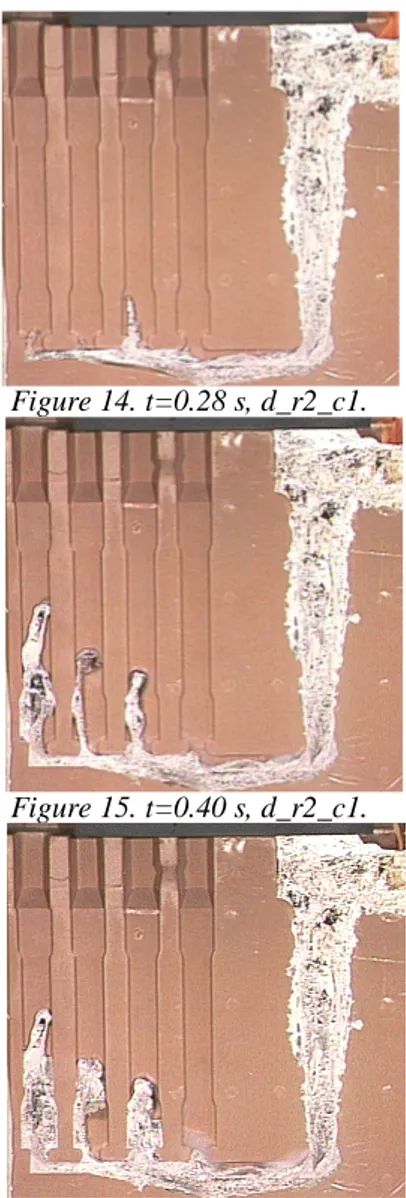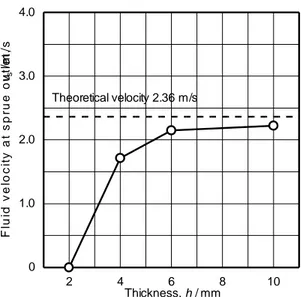Mould filling observations of aluminium melts in
vacuum-sealed sand moulds
Jonas Bäckman*, Ingvar L. Svensson* and Yasuhiro Maeda**
*
Division of Component Technology, School of Engineering Jönköping University, SWEDEN
**
Department of Materials Processing Engineering, Nagoya University, Nagoya, JAPAN
ABSTRACT
In order to clarify how the ingate system design influences the mould filling behaviour of aluminium melts in vertically parted vacuum-sealed moulds, some direct observation experiments have been made. A detailed study of how the design of each component in the ingate system affects the mould filling behaviour has been made. The effect of different designs on downsprue-runner connections, runners and end-wall of the runners as well as the effect of wall friction was investigated. The mould filling process was studied through a glass wall and recorded by a video camera. Still images from the videotape are presented and evaluated. The direct observation method has been found to be a very powerful way to follow the melt behaviour during mould filling. To ensure a good filling of the downsprue the melt level in the pouring basin has to be above a certain level from the time when the stopper is removed and during the whole filling sequence. A perpendicular connection between the downsprue and the runner gives a larger flow loss than a rounded type. Due to the larger flow loss the perpendicular connection results in an earlier filling of the downsprue. A tapered runner results in almost simultaneous filling of the specimens compared to a runner with no tapering. On the other hand the tapered runner gives a more divergent melt front which increase the free melt surfaces in contact with air. An additional pocket at the end of the runner has a beneficial effect on the mould filling. A sharp angled pocket is better than a more rounded type. Decreasing the wall thickness increases the flow loss due to wall friction, and causes more significant heat losses.
Introduction
In order to obtain a sound product and to fully use the potential of the material properties it is necessary to optimise the ingate system design and the casting conditions. There are many casting methods used for aluminium castings such as high-pressure die-casting, gravity casting and so on. In this work the vacuum-sealed process was selected for the aluminium alloy casting. The vacuum-sealed process has some advantages such as the binder-less moulding sand, the easy recycling of the sand, low draft angles required for the patterns, and so on. The moulds are vertically parted, which allows a large degree of freedom in the ingate system design.
Many researchers [1-5] have studied the ingate system. The main task when designing the ingate system is to ensure that air and oxide film inclusions are prevented, or at least minimised. This can be fulfilled if the downsprue is completely filled at an early stage of the filling, and the runner is filled in a smooth way before the melt enters the gates. It has been suggested that a critical melt velocity in the gates is 0.5 m/s to prevent surface turbulence [6]. One way to reduce the melt velocity is to use area changes where directional changes of the melt flow occur. This usually implies un-pressurised or expanding systems. When using expanding systems it is important to completely fill the ingate system before the melt enter the gates, to prevent air and oxide film inclusions.
To completely understand the mould filling behaviour it is necessary to directly observe the phenomena in experiments. In the case of water models, the operation is rather simple, but it is impossible to take into account the effect of heat transfer during casting. Observation systems using X-rays are very effective, but the images obtained by this method are diffuse and the equipment is very expensive. By using an observation system consisting of a glass wall and a video camera the surface of the melt could be measured. The experimental series contained different shapes of the parts included in the ingate system. The experiments also included studies of how the thickness of the ingate system affects the mould filling.
Experimental set-up
Experimental Apparatus
In the experiments, observations were made by using a glass wall and a video camera system. Figure 1 shows the experimental apparatus, a) the observation system and b) the vacuum-sealing moulding machine. The observation system consists of the vacuum-sealed mould, the glass wall, the supporting steel angle and the visualisation system. The visualisation system was a video camera and two strobe lights. The video camera was able to take 50 frames per second.
Figure 1a. The observation system. Figure 1b. The vacuum-sealing moulding machine.
Casting geometry
In the present study, it was investigated how different shapes of component parts in the ingate system influence the mould filling behaviour. Figure 2 shows the cavity shape in the geometry designated d-r1-p2-c2. The cavity geometry consists of a pouring basin, a downsprue, a connection part between the downsprue and the runner, a runner, a “slag” pocket at the end of the runner, four gates, four specimens and four feeders. Figure 3 shows the dimension of the four different specimen thicknesses. The different thickness of the specimens was used in order to investigate the effect of wall friction. The component parts were designed as shown in Table 1 and figure 4.
The basic geometry was designed for an un-pressurized gating system i.e. (sprue: runner: gate = 1.2:2:4). The sprue design took into consideration the effect of gravity (1.2 times the theoretical area at the top), assuming a basin depth of 50 mm. The cross-sections of the gates
were designed to keep the gate velocity below 0.5 m/s (according to Bernoulli theorem and the law of continuity). In the present paper, the cavity geometry is designated according to (specimen thickness)-(runner type)-(slag pocket shape)-(connection geometry) such as d-r1-p2-c2. The other components in the ingate system were not changed. Further, the specimens are numbered 1, 2, 3 and 4 from the outside towards the downsprue.
56 56 56 128 7 0 2 3 0 1 5 3 6 3 5 1 186 130 456 5 0 2 4 0 Basin Sprue Connection Runner Gate Feeder Specimen 1,2,3,4 Well pocket
Figure 2. Casting geometry with thickness 10 mm, runner 1, pocket 2 and connection 2 (d-r1-p2-c2).
Table 1. Ingate system conditions.
Component parts Type
Specimen a, b, c, d Runner r1, r2 Slag pocket p0, p1, p2 Connection c1, c2, c3 Lt Lc b n m a Type a b m Lc n Lt a b c d 2.0 4.0 6.0 10.0 12 12 20 30 18 18 26 36 75 75 87 137 40 40 40 40 170 170 180 230 Figure 3. Dimensions of specimens.
9 1 8 2 4 3 6 56 56 56 18 186 3 6 186 R36 36 36 3 6 79 R 15 22 130 3 6 22 3 6 130 5 1 22 22 79 130 5 1 2 2 3 6 R u n n e r r1 r2 W e ll p o c k e t None p0 p1 p2 C o n n e c ti o n c1 c2 c3
Figure 4. The different component parts of the ingate system.
Experimental procedures
The pouring starts when the stopper is removed manually from the pouring basin. The casting alloy used was AlSi10Mg, and the mould consists of binder-less silica sand, formed by the vacuum-sealed process. The pouring temperature was 700°C ± 10°C.
Experimental results and discussion
The pictures from the experiments contain lot of information, which at the present stage are difficult to evaluate and understand. The following discussion and some conclusions are subjective and constructed from the authors’ point of view. An understanding of the melt flow behaviour is not yet well developed by the metal casting community. Foundrymen that have watched the video sequences usually give the spontaneous comment, “I didn’t think that the melt behaves in this way.” By watching the video sequences the foundrymen can get a more correct picture of the melt behaviour and draw conclusions on how to optimise their ingate systems.
Influence of rounded and perpendicular connection between the downsprue and the runner
Two different types of connections between the downsprue and the runner were investigated, one with a rounded shape and one with a sharp, perpendicular edge as can be seen in figure 5-7 and figure 8-10 respectively.
Figure 5. t=0.26 s, d_r1_c1. Figure 6. t=0.36 s, d_r1_c1. Figure 7. t=0.56 s, d_r1_c1. Figure 8. t=0.26 s, d_r1_c2. Figure 9. t=0.40 s, d_r1_c2. Figure 10. t=0.56 s, d_r1_c2.
As can be seen in figures 5-10 the two different connections result in different mould filling behaviour.
- The rounded connection (c1) fills the entire downsprue at a rather late stage, which means increased risk of air and oxide film entrapments during the filling.
- The perpendicular connection (c2) on the other hand gives an earlier filling of the downsprue and probably a larger flow loss than the rounded connection.
However, both of the connections cause a very high melt velocity, and the melt splashs into the vertical end of the runner and starts to fill the most distant of the specimens first. The increase in cross-section area from the sprue to the runner has no effect in reducing the velocity of the melt before it enters the gates. This is due to the high velocity of the melt in the runner and the shaping of the end wall of the runner.
The runner is not completely filled until the castings are more or less filled.
Influence of a tapered and a uniform runner design
Two different types of runners were investigated. A tapered runner and a runner with unchanged cross-section area throughout its full length. Figures 11-16 show how the different design of the runners affects the mould filling behaviour. The connection between the downsprue and the runner is the rounded type.
Figure 11. t=0.26 s, d_r1_c1 Figure 12. t=0.36 s, d_r1_c1. Figure 13. t=0.56 s, d_r1_c1. Figure 14. t=0.28 s, d_r2_c1. Figure 15. t=0.40 s, d_r2_c1. Figure 16. t=0.52 s, d_r2_c1.
As seen in figures 11-16 the mould filling differs significantly between the runner goemetries.
- The first runner (r1) results in sequential filling of the specimens, which causes a very high velocity in the corresponding gate and consequently a very turbulent filling.
- The tapered runner (r2) gives rise to almost simultaneous filling of the specimens, but the high velocity of the melt leads to impingement of the melt with the roof of the runner, leading to a divergent melt front before the runner is completely filled (as seen in figure 14).
Influence of the shape of the pocket at the end of the runner
Two different types of pocket at the end of the runners have been examined. One of the pockets had a rounded shape while the other had a sharp angle. Figures 17-22 shows how the different design of the pockets affected the mould filling behaviour.
Figure 17. t=0.38 s, d_r1_c3_p1. Figure 18. t=0.48 s, d_r1_c3_p1. Figure 19. t=0.62 s, d_r1_c3_p1. Figure 20. t=0.32 s, d_r1_c3_p2. Figure 21. t=0.44 s, d_r1_c3_p2. Figure 22. t=0.68 s, d_r1_c3_p2.
Compared to the case when no pocket is present, an additional pocket is beneficial to the mould filling behaviour. The pocket acts as a direction changer for the melt, and prevents the melt from entering the gates at an early stage of the filling. The sequential filling becomes less characteristic and the gate velocity is reduced.
The initial condition in the two experiments with additional pocket at the end of the runner is that the melt level in the pouring basin differs, which results in different degree of filling of the downsprue. It will also result in different filling times. The connection between the downsprue and the runner is changed from the previous section and now has a more abrupt change in cross-section area from the downsprue to the runner.
- The rounded pocket (p1) give a large curl of the melt front and presumably more oxide film inclusions.
- The sharp-angled pocket (p2) give also a curl of the melt front but the effect is smaller.
The filling seem to be faster in the case with the sharp-angled pocket but this is probably an effect of the low melt level in the pouring basin in the experiment with the rounded pocket.
Influence of wall thickness
The effect of the melt surface tension and the wall friction on the mould filling behaviour has been investigated at four different wall thickness, 2, 4, 6 and 10 mm. Compared to the theoretical velocity, obtained from the Bernoulli equation, the actual velocity in the sprue outlet was reduced due to the overall friction. In figure 23 the velocity at the outlet of the sprue for different wall thicknesses is presented.
2 4 6 8 10 0 1.0 2.0 3.0 4.0 Thickness, h / mm
Fluid velocity at sprue outlet,
vs
/m/s
Theoretical velocity 2.36 m/s
Figure 23. Sprue outlet velocity for different wall thickness.
The sprue outlet velocity decreases with decreasing wall thickness. The frictional effects on the melt flow rate become more and more severe as the wall thickness decreases. This effect, combined with the increasing viscosity as the melt temperature decrease, leads to freezing of the melt in the downsprue for a wall thickness between 2 and 4 mm. The heat transfer to the ceramic glass is assumed to be very high, which results in faster cooling of the melt. This cooling effect is not so severe when an ordinary sand mould is used instead of the glass wall. In addition, the melt surface tension will be increased by the formation of a thin but solid aluminium oxide film layer. The strength of the oxide film created will be proportional to the thickness, and as the flow rate decreases it will probably give a larger resistance. It is suggested that the surface tension and the wall friction effect should not be neglected when the wall thickness is below approximately 6 mm, in accordance with figure 23.
Conclusions
To ensure a good filling of the downsprue the melt level in the pouring basin has to be above a predefined level from the time when the stopper is removed and during the whole filling sequence.
A perpendicular connection between the downsprue and the runner results in a larger flow loss than a rounded type when changing the direction of the melt flow. Due to the larger flow loss the perpendicular connection results in earlier filling of the downsprue.
A tapered runner gives a more simultaneous filling of the specimens than a runner with no tapering does. On the other hand the tapered runner gives a more divergent melt front which increase the free melt surfaces in contact with air.
An additional pocket at the end of the runner has a beneficial effect on the mould filling. A sharp angled pocket is better than a more rounded type.
Decreasing the wall thickness increases the flow loss due to surface tension and wall friction, and also causes a more significant heat loss, which results in earlier freezing of the melt.
Acknowledgement
The authors would like to thank the personnel at Saab Training Systems AB for their help with the experiments, and the K.K.-foundation for their financial support.
References
[1] Xu Z. A. and Mampaey F., AFS Trans., pp. 181-190, (1994)
[2] Sirrell B., Holliday M. and Campbell J., Modelling of Casting, Welding and Advanced Solidification Processes VII, Edited by M. Cross and J. Campbell, The Minerals, Metals & Materials Society, pp. 915-933, (1995)
[3] Mampaey F. and Xu Z. A., Modelling of Casting, Welding and Advanced Solidification Processes VII, Edited by M. Cross and J. Campbell, The Minerals, Metals & Materials Society, pp. 3-14, (1995)
[4] Xu Z. A. and Mampaey, F., “Mold filling of horizontal castings and influence of a filter”, AFS Trans., Vol. 105 (USA), pp. 853-860, (1998)
[5] Runyoro J. and Campbell J., ”The running and gating of light alloys”, Conference: Developments in Light Alloy Castings, Birmingham, England, 2-3 September, (1991)
[6] Runyoro J., Boutorabi S. M. A. and Campbell J., ”Critical gate velocity for film-forming casting alloys: A basis for process specification”, AFS Trans., Vol. 100, pp. 225-234, (1992)






